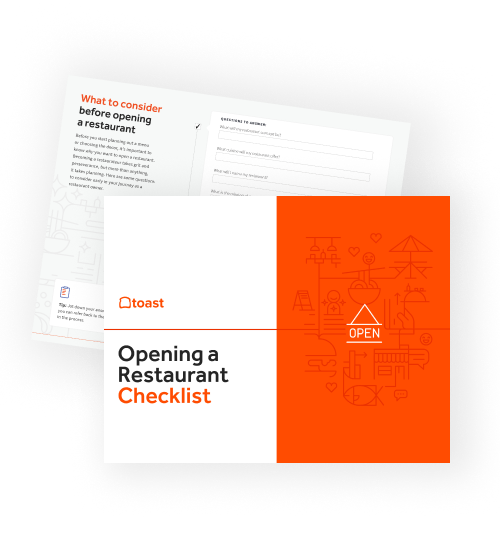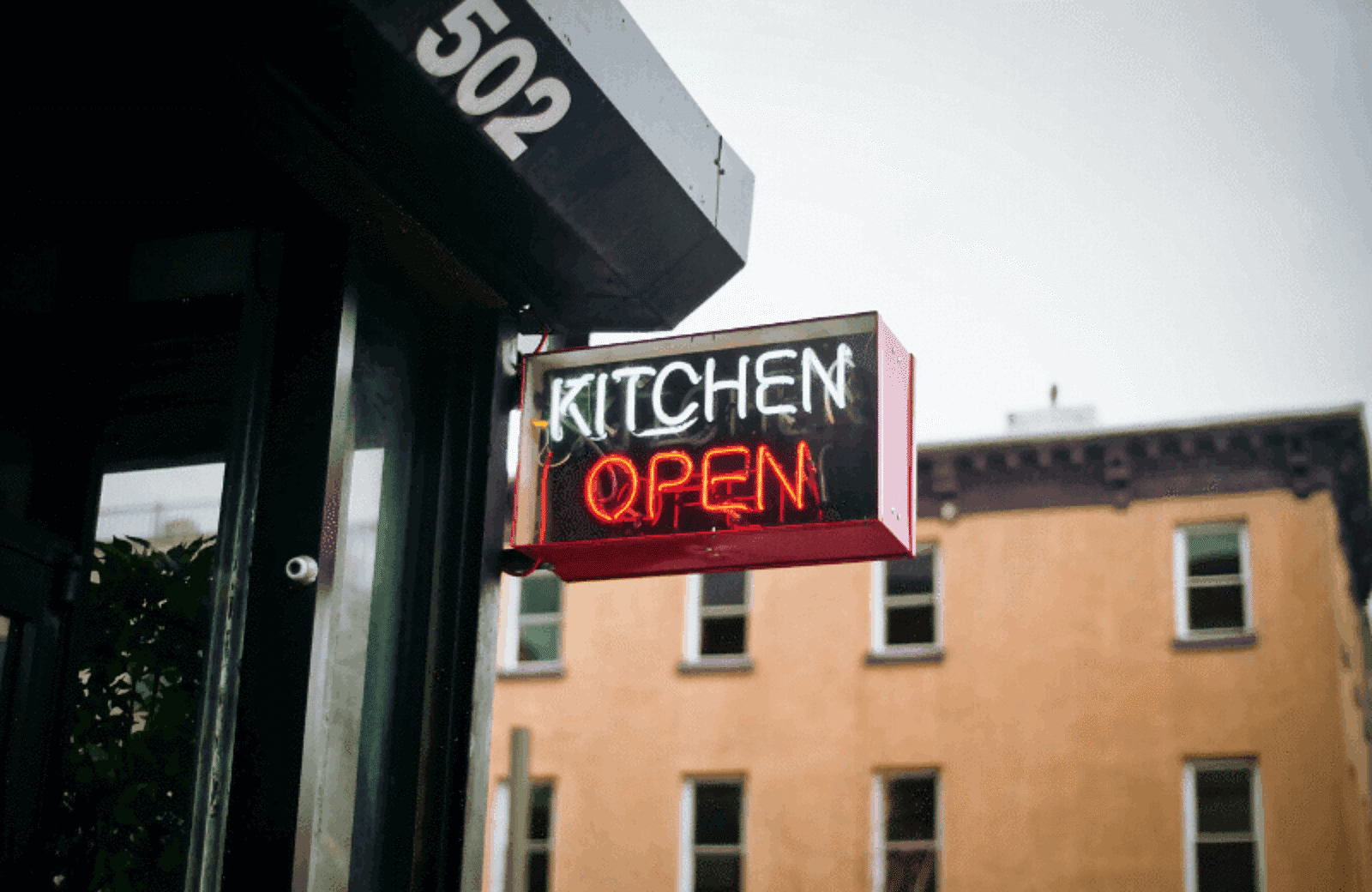
How to Open a Food Business: Starting a Food Business Steps
There’s so much more to the food and beverage industry than just full-service restaurants. Learn about the different types of small food businesses and how you can start the food business of your dreams.

Caroline PriceAuthor


Opening a Restaurant Checklist
So many things go into opening a restaurant. Use this free PDF checklist to set your new restaurant up for success.
Get free downloadWhat Do You Need to Start a Food Business? (Checklist)
Opening a new restaurant isn't the only way to launch a food business. There are plenty of other ways to create and operate a successful food business aside from a full-service establishment. And now more than ever, aspiring entrepreneurs and food lovers need to be creative and carefully consider all opportunities before launching any food business.
To start, here’s a short list of some of the most common types of small food businesses.
Types of small food businesses
Full-service restaurant
Quick-service (or counter service) restaurant
Food truck
Food cart
Ghost kitchen
Cafe
Specialty grocery store
Butcher shop
Deli
Specialty food production
Food prep or meal box service
Specialty frozen food store
Personal chef
Caterer
It’s important to weigh lots of different factors when choosing what kind of business to start, including how much experience you have in a specific business area, who you can hire to help you along the way, and how much funding you can secure — not to mention the all-important factor of what consumers in your area want.
For example, ghost kitchens are especially relevant in a post-COVID age, where more and more restaurants are evolving and growing food delivery and takeout options. And specialty food companies are a great option for entrepreneurs who have perfected a product, like hot sauce or jam.
Whatever concept fits your expertise and idea, here are 9 steps for opening a restaurant.
How to start a small food business
Create a business plan
The first step to starting a food business is laying out the details by creating a business plan. A restaurant business plan outlines both the scope and specifics of your idea. It explains in detail what your business is, how it will open and operate, and includes information about your competitive market, financial analysis, and promotional plans.
Business plans provide more than just a blueprint for the owners. It also provides an outline for all parties involved, including potential investors, banks, and business partners.
Learn more about how to build a restaurant business plan and the sections to include here and here.
Restaurant Business Plan Template
No matter where you’re at in your restaurant ownership journey, a business plan will be your north star. Organize your vision and ensure that nothing is overlooked with this free template.

Find small business funding
There are many different ways to go about securing capital to fund your new venture. Some of the most accessible kinds of restaurant funding include bank loans, SBA loans, equipment financing, alternative loans, and more. To learn in-depth about all of these options and more, check out this post.
Find a location or a shared commercial kitchen
Location is essential for a successful business — especially for food businesses that rely on location for traffic, like cafes, specialty grocery stores, food trucks, or food carts.
In those cases especially, you’ll want to identify the location of your ideal or target customers. Create a clear description of who you’re looking to attract as a guest. Where do they live? What do they spend their time doing? What is their income level? This will help you identify what neighborhoods make the most sense for you to operate from.
From there, look into market conditions in that area: what do the buyer demographics, economic statistics, and overall traffic (both car and foot) look like? Here, you’ll also think about the competition in the area.
Once you’ve set your sights on a specific area, you can start looking at real estate. You’ll want to make sure that whatever site you choose makes sense in terms of size and capacity, foot traffic and visibility, and of course, price. For more information on restaurant real estate, check out this post.
And if you’re looking for a commercial kitchen to rent alongside other small food businesses, ask around at local markets and do an online search to find one that suits your needs, and make sure that the space is licensed to support your type of business. In some cases, restaurants rent their space one night a week when they’re closed to the public, to a small business that needs a health-inspector-approved area of operation.
Rent or buy the equipment and tech needed
Restaurants need an extensive list of equipment to run well. And, in order to fully build out your business expenses and business plan, you’ll need to know exactly how much the necessary equipment will cost.
There is a lot to consider when looking into buying restaurant equipment, including quality, space considerations, pricing, suppliers, and longevity. You’ll want to make sure the equipment is within your budget, high-quality, and long-lasting.
You can find a full checklist of the essential restaurant equipment here, along with important things to consider before buying.
Along with kitchen equipment, you’ll need to figure out what technology is needed to best run your business. This includes a point of sale system, printers, kitchen display systems, and more. Find a full list of the most important types of restaurant technology here.
Hire your dream team
A restaurant cannot thrive without a strong team, and neither can a small food business. Great employees create great guest experiences, so it's essential that you find experienced employees that believe in your mission.
In order to attract and retain the best talent, you’ll want to make sure that you have a great staff culture.
Here’s a list of restaurant positions to immediately hire for, and how to make sure your restaurant or business is a great place to work.
Market your small business
Once you’ve got your menu or products set, construction done and staff hired – it’s time to start planning your promotional strategy. And remember: whatever your concept is, guest expectations have changed. COVID-19 has fundamentally changed the food and beverage industry as a whole, challenging owners and operators of all food businesses to adapt in ways never seen before.
What will set you apart from your competition is how you market your business, build guest relationships, and provide the best overall experience. Great marketing is fundamental to building those long-lasting guest relationships and keeping them coming back again and again.
A great place to start is by building your restaurant marketing plan.This resource, which can be adapted for any type of food business, will walk you through effective ways to use popular restaurant marketing channels, from social media to email marketing and beyond.
Soft launch your small business
Before you jump into daily service, consider a soft opening to test out your food, systems, and processes. The soft opening usually is for friends and family of the staff and owners, neighbors, and vendors or other business partners.
At the soft opening, your staff has an opportunity to work together as a team for the first time, without the pressure of strangers (and those who might be less forgiving for small, correctable mistakes). This gives you an opportunity to work through any complications and perfect your processes for the real opening day.
And, it’s also a way to celebrate and share your accomplishment with those closest to you.
Throw a grand opening
You did it! Once you have everything all set, it’s time to open your business to the public.
This is the first shift that you’ll run fully open to consumers. Whether you host a grand opening party or just quietly open your doors, make sure to enjoy this moment and share it all over social media.
Remember that even post-soft-opening, it’s unlikely that everything will go off completely smoothly. There will likely be mistakes, but it’s all part of the learning process as you adapt and grow as a new food business.
Keep an eye on KPIs
Obviously, the work (and joy!) doesn’t end with the opening party. As you swing into the day-to-day running of your business, make sure to keep an eye on KPIs, or key performance indicators. KPIs let you know how your business is doing, and include metrics such as cash flow, cost of goods sold, guest retention, and guest feedback.
There is always room for improvement, so make sure to stay on top of your financials, listen and solicit feedback, and constantly look for opportunities to grow.
And there you have it! While this isn’t a fully exhaustive list, each of these aspects are important as you get ready to open your new food business. For more information on opening a new restaurant business, check out this full beginners guide.
Is this article helpful?
DISCLAIMER: This information is provided for general informational purposes only, and publication does not constitute an endorsement. Toast does not warrant the accuracy or completeness of any information, text, graphics, links, or other items contained within this content. Toast does not guarantee you will achieve any specific results if you follow any advice herein. It may be advisable for you to consult with a professional such as a lawyer, accountant, or business advisor for advice specific to your situation.
Read More
Subscribe to On the Line
Sign up to get industry intel, advice, tools, and honest takes from real people tackling their restaurants’ greatest challenges.



